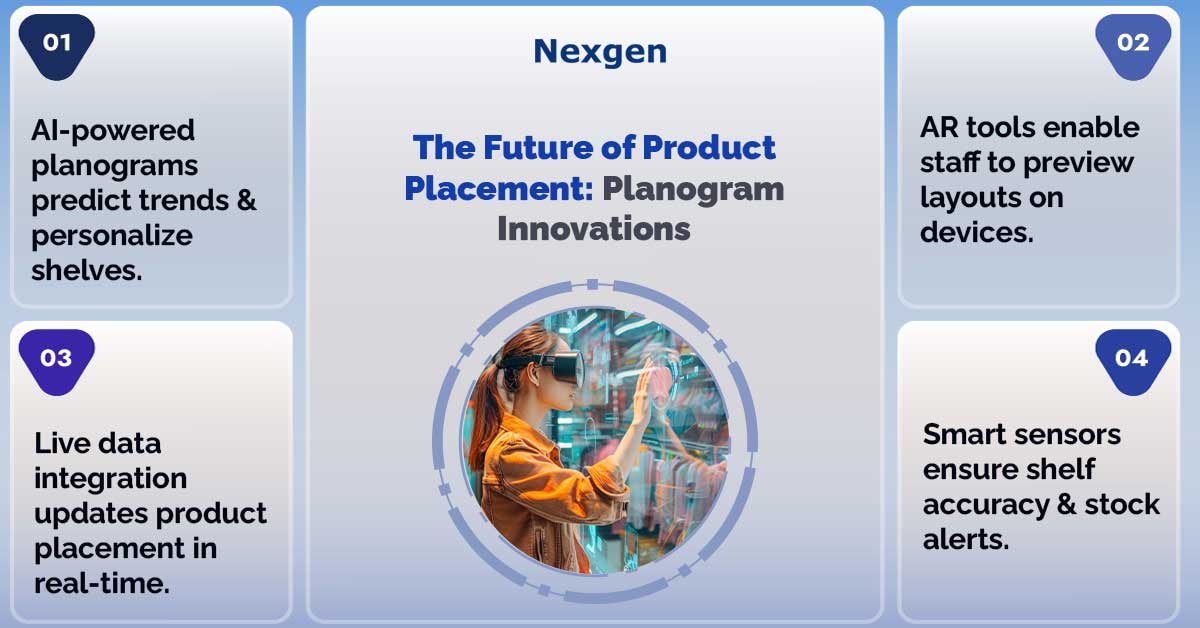While traditional product placement was often a matter of simple organization and merchandising, today’s retailers are embracing innovation to optimize how they showcase their products. At the forefront of these are planograms, digital tools that visually map out the ideal arrangement of products on store shelves.
But as technology continues to advance, so does the potential for innovation in planogram technology. From artificial intelligence (AI) to augmented reality (AR), the next wave of planogram innovations is set to reshape the way retailers approach product placement. Here is a look at what is next for planograms and how these advancements are poised to drive the future of retail.
1. AI-driven planograms: Smarter, faster, and more personalized.
Artificial intelligence has already made significant strides in retail, and its influence on planogram technology is becoming increasingly prominent. AI can analyze vast amounts of data from multiple sources: sales trends, customer behavior, inventory levels, and even external factors like weather or events to create more accurate and predictive planograms.
Instead of relying solely on past performance, AI can optimize product placement by anticipating future trends. For example, it can adjust the positioning of products based on factors like emerging consumer preferences or competitive pricing strategies. The result is a planogram that is not only based on historical data but also forecasts what customers are likely to buy next.
By analyzing customer segments, AI can suggest specific layouts for different types of shoppers, tailoring product placement to maximize relevance and conversion. This level of personalization could significantly enhance the shopping experience and boost sales, especially in stores with diverse customer bases.
2. Augmented Reality (AR) for in-store visualization and layout adjustments.
One of the most exciting innovations on the horizon is the integration of augmented reality (AR) with planogram technology. While AR has already gained traction in areas like product visualization and virtual try-ons, its potential in product placement is still being explored.
Instead of manually adjusting shelves based on static layouts, they could use AR to superimpose new product placements directly onto their store shelves through their smartphones or AR glasses. This virtual representation could provide an immediate, interactive preview of how the layout would look, enabling more efficient decision-making without the need to physically move products.
Additionally, AR could allow customers to interact with in-store displays in new and engaging ways. Imagine walking through a store and using your phone to scan shelves, where AR overlays additional product details, recommendations, or promotions. This could create a more immersive shopping experience while driving product discovery and sales.
3. Real-time data integration for dynamic planograms.
Gone are the days of static, long-term planograms that remain unchanged for months. By syncing planograms with live sales data, inventory levels, and even social media trends, retailers can make instant adjustments to their layouts in response to current conditions.
For example, if a certain product is flying off the shelves due to a viral trend or sudden demand spike, the planogram can be automatically updated to allocate more shelf space to that product. This real-time flexibility allows retailers to optimize their store layouts without waiting for the next scheduled update, improving both efficiency and sales potential. With advancements in cloud technology, real-time planogram updates can be deployed across multiple locations simultaneously, ensuring consistency and responsiveness across entire retail chains.

4. IoT-enabled planograms for shelf compliance.
The Internet of Things (IoT) is transforming retail by connecting products, shelves, and even entire stores to a network of sensors and devices. This technology can be integrated with planogram systems to automate shelf management and ensure compliance with merchandising guidelines.
For example, IoT sensors placed on shelves can track product availability, monitor stock levels, and even check for any deviations from the planned product placement. If a product is out of stock or misplaced, the system can alert store staff to restock or reposition the item, ensuring the store layout remains as optimized as possible. This integration not only helps maintain consistent shelf compliance but also provides valuable insights into how products are performing in real time. Retailers can make data-driven decisions about which products to feature more prominently or which layouts are generating the most traffic.
Overview of Nexgen POG
Nexgen POG is a robust and user-friendly cloud-based visual merchandising tool. It is designed for quick and efficient planogramming with minimal effort. Planograms in retail can be designed by easily dragging and dropping the products. The multi-device compatibility feature of POG allows you to obtain, share and edit planogram on any device, including your phone. It helps in designing store-specific planograms for increased product visibility and sales.
Get Your Free Trial Now!